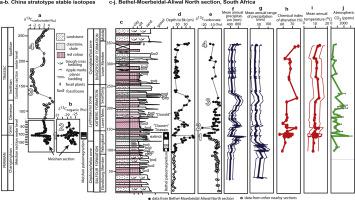Global and Planetary Change ( IF 3.9 ) Pub Date : 2021-01-04 , DOI: 10.1016/j.gloplacha.2020.103415 Gregory J. Retallack

|
The largest mass extinction in the history of life was during the Late Permian, ca 252 Ma. New evidence from stable isotopic composition and Bk metrics of paleosols from the Late Permian to the Middle Triassic in the southern Karoo Basin of South Africa, reveal at least four atmospheric carbon dioxide spikes, coinciding with extinctions on land and at sea. The Karoo Basin was mainly arid throughout this interval, but the four life crises correlate with extreme greenhouse spikes of carbon dioxide and transient episodes of warmer and more humid climate, with respiratory distress for vertebrates and roots of wetland plants. These most extreme greenhouse crises in the history of life provide worst-case scenarios for modern global climate change.
中文翻译:

陆上和海上多重二叠纪-三叠纪生命危机
生命史上最大规模的灭绝是在二叠纪晚期,大约252 Ma。来自南非南部卡鲁盆地晚二叠世至中三叠纪古土壤的稳定同位素组成和Bk度量的新证据表明,至少有四个大气二氧化碳峰值,这与陆地和海洋的灭绝相吻合。Karoo盆地在整个这段时间里主要是干旱的,但是这四个生命危机与二氧化碳的极端温室效应,温暖和潮湿的气候的短暂发作,脊椎动物和湿地植物的根源有关。生活史上最严重的温室危机为现代全球气候变化提供了最坏的情况。



























 京公网安备 11010802027423号
京公网安备 11010802027423号